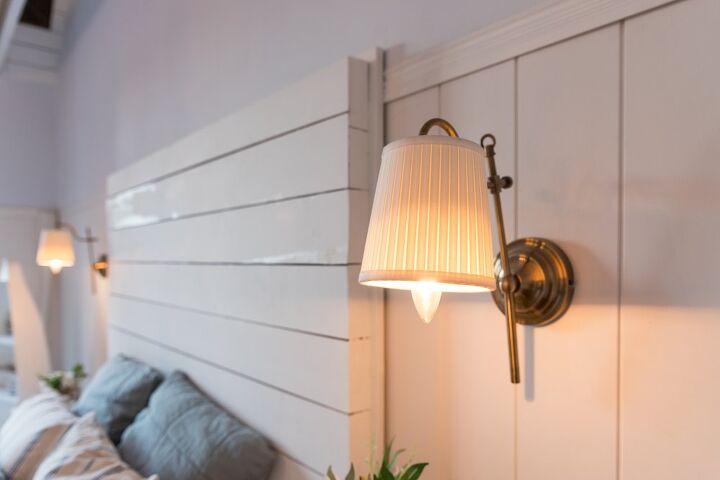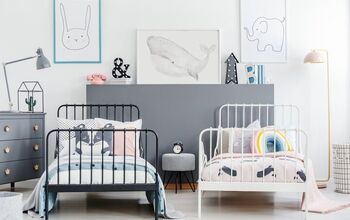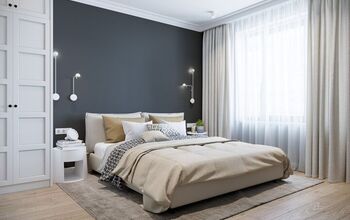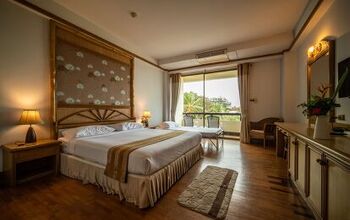What Size Light Fixtures For A Bedroom?

When looking for lighting, it can make you feel like Goldilocks: you want something that is just right—not too big, not too small, not too harsh, not too soft. Your attitude and degree of comfort are definitely influenced by the quantity and quality of illumination in a space. You should pick light fixtures that are the appropriate size, particularly in a bedroom where comfort is important. But, what size do you need for a bedroom?
To determine the size of light fixture you need for your bedroom, figure out your room’s square footage. Then, multiply the square footage by 1.5 to get the kilowatt capacity. For instance, a room that is 180 square feet will need a kilowatt capacity of 270 or above to be sufficient.
In this article, we will talk more about the size of light fixtures for your bedroom, so you know how to best choose the right one to illuminate your space. Let’s get started.
Bedroom Dimensions
Your choice of fittings is influenced by the ceiling height. The size of your space will determine which light fixtures are appropriate for your bedroom.
A room with a towering cathedral ceiling might require light fixtures that hang and direct the light’s focus to the lower walls and floor.
However, a bedroom with a low ceiling might benefit from multiple smaller lamps that disperse pools of light upward. In a tiny space, a single large overhead fixture may visually lower the ceiling because it appears heavy.
Room Dimensions and Fixture Diameter
To determine the diameter of your overhead fixture, use the room dimensions. According to Karen Davis Design, designers advise using a formula to determine a single bedroom light fixture’s aesthetic and illuminating capability.
Measure the room’s length and width in feet; for instance, 12 feet by 15 feet. 12 + 15 = 27, when the length and width are added together.
To determine the diameter of an overhead fixture that will look good in your room, replace inches for feet. The diameter of a fitting that will fit in your 12- by 15-foot room is twenty-seven inches.
Room Dimensions and Wattage
Make sure the lighting meets your wattage requirements. The wattage capacity of the fixture should also be taken into account. If a massive chandelier can only hold 25-watt bulbs, it is useless. To calculate the amount of wattage required to light your room, use a separate method based on measurements.
Add the length of your room to the breadth. You receive a total of 180 square feet for the 12-by-15-foot room. Simply double this number by 1.5; 180 x 1.5 equals 270. For your room, a light fixture with a kilowatt capacity of 270 or above should be sufficient.
Multiple Lighting Needs
Consider activity patterns when selecting lighting fixtures. Your total wattage serves as a basic benchmark and will spread ambient light around the space.
To evaluate whether you need more fixtures, observe how your bedroom is used. For example, closets and spaces designated for reading, sewing, hobbies, desk work, or exercising can both benefit from more lighting.
Task-light spaces are what they are named. One lighting technique is to use the bed area as the main lighting focal point in a big room. Consider the region around your bed as a different zone and place the ceiling lighting over that area rather than placing one ceiling fixture in the room’s center.
You may concentrate on lighting a 10-foot-by-15-foot sleeping area in a 15-by-20-foot bedroom. For each of the extra main activity areas, add more lamps, wall fixtures, or pendant lighting.
Creating Flexible Lighting
So that you may generate a range of looks in your bedroom, make your lighting versatile. It is possible to target certain regions for soft or bright light and so conserve energy by having lights on different switches.
Dimmer switches are available for different lights besides the main ceiling fixture. With dimmers, you may produce a glow that permeates the entire space or gentle pools of light.
Overhead Lighting
A powerful overhead source of light should be used to illuminate the entire room starting at the top. There is a variety of ceiling lights to pick from, so you can make a statement in locations with high ceilings with a beautiful contemporary pendant light or go for a more traditional style with a semi-flush or flush installation.
Clay shades can offer any room a natural, organic vibe. Many of the lighting collections out there come with a variety of adaptable fixtures so you may design a look specifically for your room. Because of course, the way your room looks is just as important as the lighting itself.
How Large of a Pendant Light for a Bedroom?
Add the room’s width and length in feet, then use the total to calculate the diameter of your lighting in inches to choose the appropriate size ceiling fixture. For instance, a 22-inch diameter pendant would look best in a 10-by-12-foot bedroom.
Try to keep the distance between the floor and the bottom of the shade at least seven feet when it comes to hanging height, but if your light hangs right above the foot of the bed, hanging it a little lower will give the space a more intimate, warm atmosphere.
Depending upon the size of your ceiling, calculate the size of your ceiling fan pendant. To add more light to your space, pick a light and fan combo.
To equalize the entire proportion of your light fixture in proportion to your space, use the diameter of the fixture as an easy reference point. For customization possibilities for each area.
Task Lighting
In addition to serving a practical purpose, bedside lighting can give your entire room personality. Task lighting gives your bedroom more purpose and can light up reading before bed, your closet, and gloomy nooks. Ideal reading lighting is provided by wall sconces on either side of the bed, which also leave extra room on the bedside table for supplies and your favorite books.
For the ability to direct light where it is most needed, think about using a sconce instead of an overhead light. Additionally, you can add wall illumination next to a floor-length mirror or within your closet. This is perfect to put above a desk, or near your bedside.
Where Should You Place a Sconce in Your Bedroom?
Your ceiling height, the size of your nightstand, and the height of your bed will determine the best height and location for your bedside sconces. Sconces should, as a general rule, be placed two to four feet and four to six inches away from the headboard’s side.
It’s crucial to put your sconces where the light won’t be seen from above or produce glare when you’re sitting up straight in bed reading because these measurements vary based on your area and bed size. Make sure to give room for other components in the room, such as nearby drapes or windows.
Without requiring extra installation or electrical labor, plug-in sconces offer a simple method to personalize your bedside illumination. To learn how to install a plug-in sconce, watch our video tutorial.
Remember that your fixture’s shade will also affect the kind of light it produces; a dark shade will direct the light downward, which is great for reading.
A warmer glow will be infused for more ambient lighting if you choose a lighter shade. To discover the ideal fit, browse our selection of hardwired and plug-in sconces.
What Size Should a Bedroom Chandelier Be?
Your room’s length and breadth should be measured, and the two measurements should be added. The diameter of an appropriate-sized chandelier is the result in inches.
For instance, the ideal chandelier will have a diameter of about 25 inches if your space is 12 feet broad and 13 feet long.
How Many Lights Should a Chandelier Have in a Bedroom?
Add 1.5 to the figure to get the total wattage needed to illuminate the room, then multiply the width by the length of the room to get the required wattage for the bedroom chandelier. For instance, a bedroom measuring 12 by 14 feet needs 252 total watts.
Can a Chandelier Be Too Big?
A chandelier that is too big can quickly overwhelm a space and the people using it, while one that is too little diminishes the apparent value of the entire area. You may enhance the impact of the fixture by picking the right size by adhering to a few interior design rules.
How Do I Know What Kind of Light Fixture I Need?
Choose light fixtures of different types. Choose lighting fixtures that cast light in a variety of planes and angles. Additionally, observe the shade’s shape to determine how much and in what direction the light will be dispersed.
The type of lighting you choose highly depends on your personal preference and style. Not everyone appreciates a chandelier in their bedroom. However, not everyone wants a small ceiling light either.
As long as you stick with the proper wattage compared to your square footage, and stick to your personal style, you can’t go wrong when selecting a light for your bedroom.

Heather is a passionate writer who loves anything DIY. Growing up, she learned everything from home repairs to design, and wants to share her tips with you. When she's not writing, she's usually hiking or searching for her next DIY project.
More by Heather Robbins



























